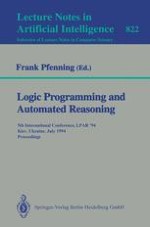1994 | Buch
Logic Programming and Automated Reasoning
5th International Conference, LPAR '94 Kiev, Ukraine, July 16–22, 1994 Proceedings
herausgegeben von: Frank Pfenning
Verlag: Springer Berlin Heidelberg
Buchreihe : Lecture Notes in Computer Science
Enthalten in: Professional Book Archive
